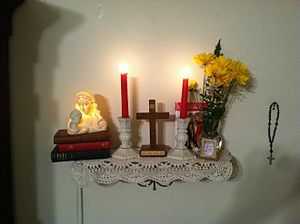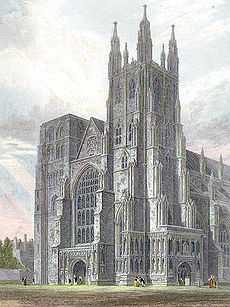Anglican prayer beads

Anglican prayer beads, also known as the Anglican rosary or Christian prayer beads, are a loop of strung beads which Anglicans, as well as Christians of other denominations, use to order their prayer. This particular way of using prayer beads was developed in the mid-1980s by Episcopalians in the United States participating in a study group dealing with methods of prayer. The beads have since been adopted or adapted by Lutherans, Methodists, and other Protestant groups, thus giving rise to the term "Christian prayer beads".[1][2][3]
Beads
Anglican prayer bead sets consist of thirty-three beads divided into groups. There are four groups consisting of seven beads with additional separate and larger beads separating the groups. The number thirty-three signifies the number of years that Christ lived on the Earth, while the number seven signifies wholeness or completion in the faith, the days of creation, and the seasons of the Church year.[4]
Groupings

The groupings are called "weeks," in contrast to the Dominican rosary which uses five groups of ten beads called "decades." The beads between are usually larger than the "weeks" beads are called "cruciform" beads. When the loop of beads is opened into a circular shape, these particular beads form the points of a cross within the circle of the set, hence the term "cruciform." Next after the cross on Anglican prayer bead sets is a single bead termed the "invitatory" bead, giving the total of thirty-three. The beads used are made of a variety of materials, such as precious stones, wood, colored glass, or even dried and painted seeds.
Anglican prayer bead sets are made with a variety of crosses or, occasionally, crucifixes. The Celtic cross and the San Damiano cross are two which are often used.
Prayer
Unlike the Dominican rosary used by Roman and Anglo Catholics, which focuses on the seminal events in the life of Christ and asks the Virgin Mary to pray for their intentions, Anglican prayer beads are most often used as a tactile aid to prayer and as a counting device. The standard Anglican set consists of the following pattern, starting with the cross, followed by the Invitatory Bead, and subsequently, the first Cruciform bead, moving to the right, through the first set of seven beads to the next Cruciform bead, continuing around the circle. He or she may conclude by saying the Lord's prayer on the invitatory bead and/or a final prayer on the cross as in the examples below. The entire circle may be done thrice, which signifies the Holy Trinity.[4]
The Cross
In the Name of God, Father, Son, and Holy Spirit. Amen.
The Invitatory
O God make speed to save me (us),
O Lord make haste to help me (us),
Glory to the Father, and to the Son, and to the Holy Spirit: As it was in the beginning, is now, and will be forever. Amen.
The Cruciforms
Holy God,
Holy and Mighty,
Holy Immortal One,
Have mercy upon me (us).
The Weeks
Lord Jesus Christ, Son of God,
Have mercy on me, a sinner.
The Lord's Prayer
Our Father, who art in heaven,
hallowed be thy Name,
thy kingdom come, thy will be done,
on earth as it is in heaven.
Give us this day our daily bread.
And forgive us our trespasses,
as we forgive those who trespass against us.
And lead us not into temptation,
but deliver us from evil.
For thine is the kingdom,
and the power, and the glory,
for ever and ever. Amen.
The Cross
I bless the Lord.
(Let us bless the Lord
Thanks be to God.)[5]
See also
- Anglican Communion
- Prayer beads
- Anglican devotions
- Quiet time
References
- ↑ "Christian Prayer Beads Central". Net Ministries, Inc. Retrieved 2007-10-18.
Episcopalians, Anglicans, Lutherans, Methodists, Baptists, Disciples, Presbyterians, and Non-denominational Christians are only some of those who have adopted them for their own use.
- ↑ Mary: The Imagination of Her Heart by Penelope Duckworth 2004 ISBN 1-56101-260-2 page 118
- ↑ The Rosary for Episcopalians/Anglicans by Thomas Schultz 2003 ISBN 1-58790-055-6
- ↑ 4.0 4.1 "Anglican Prayer Beads". King of Peace Episcopal Church. Retrieved 2007-10-18.
- ↑ "Trisagion and Jesus Prayer". King of Peace Episcopal Church. Retrieved 2007-10-18.
